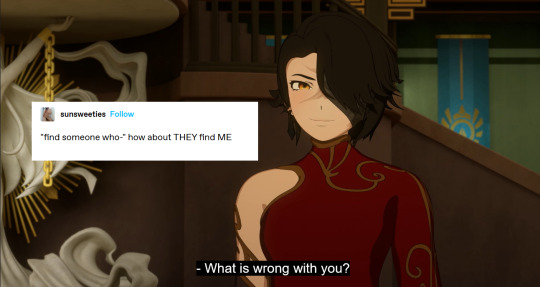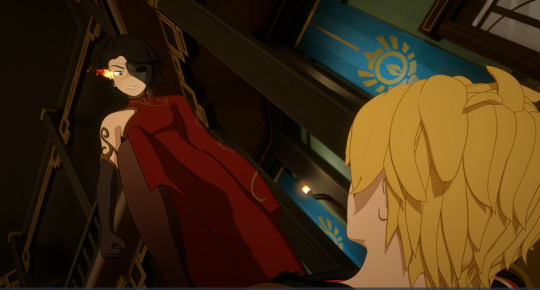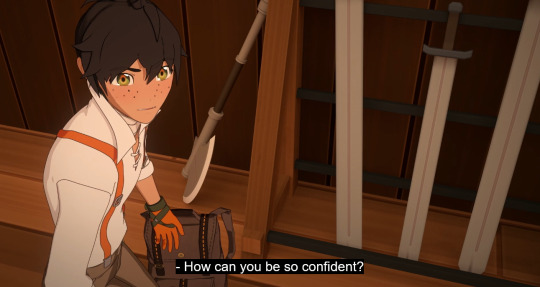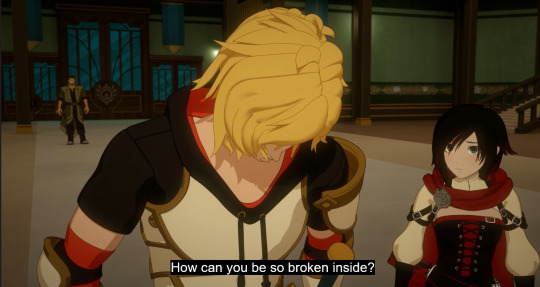Don't wanna be here? Send us removal request.
Text
I wonder what Cinder is up to right now...
7 notes
·
View notes
Text
A brief Knightfall masterpost
Also known as Arcfall, Arcfurnace, and other variations within the fandom. Knightfall is the one I like.

A quick and dirty collection of reasons the ship Cinder Fall/Jaune Arc is worth speculating about in canon, seriously.
This isn't meant to be comprehensive, rather a reference post I can use and something which might pique your curiosity for further reading. You can find more under my Knightfall tag. My real, lengthy Knightfall manifesto is a fic called The Distance Which Fools the Skimming Eye. Ha!!!!
This post also takes for granted that Cinder's redemption - and the redemption of the Maiden powers in tandem - will happen. I consider Knightfall and Cindemption interrelated. You can read more under my Cindemption tag.
I haven't used a read-more, since they're an inbuilt feature of Tumblr now, and otherwise unwieldy.
I'm going to summarise the main stuff I talk about with a paragraph for each section. I have tagged where applicable of whom I first heard about these points from. Unless otherwise denoted, it's my own analysis.
The background of Cinder and Cinderella, and Rhodopis
Rhodopis, considered a proto-form of the Cinderella fairytale type, was a figure written about by both Herodotus and Strabo. Strabo is the form you might be more familiar with, involving the sandal (analogous to the glass slipper) and her marriage to an Egyptian king. Herodotus treats her as a historical figure, and mentions that - during her second enslavement, under her second master - the brother of Sappho freed Rhodopis and fell in love with her. Jaune's sister, Sapphron (inspired by Sappho) features in V6, and Rhodopis means 'rose-faced' - Cinder is a key foil to Ruby as her Jungian Shadow. For that matter, Cinder is enslaved by Madame and then later Salem. Rhodes - though somewhat etymologically under debate - seems like an obvious nod to Rhodopis (who, for that matter, is simply found on the Wikipedia page for Cinderella). I believe that Cinder isn't necessarily only a bad ending Cinderella, but rather that disguised here is Rhodopis' story: two enslavements, and ultimate freedom. I also think we deserve a Prince Charming!Jaune, thank you very much. I first found out about Rhodopis through @iressent, whom I believe may have got it from @megashadowdragon, but I can't be certain.
The Indecisive King
A RWBY fairytale, it features a king struggling with the future shown to him with the Relic of Choice, and a widow who helps him overcome his struggles, and falls in love with him and marries him - they rule as king and queen side-by-side. There is now an animated version available. Cinder is consistently coded as a Queen, both her callsign and the fact she's a Maiden, and 'checkmates' Ironwood. As the Fall Maiden, her Relic is the Relic of Choice, and likely the last to be discovered. Jaune is a widower, in a sense, because of Pyrrha's death, though this is a bit more speculative, but still fitting (I should think). There are more details which line up between Jaune and Cinder and this story, which you can find under my Indecisive Queen tag. It is also fitting that of the five present in the Beacon Vault, the two surviving members are the ones to meet over the final Relic, in a rhyming scheme. @iressent was the first person to point out The Indecisive King to me, linking a post by @megashadowdragon once again.
Jaune and Joan of Arc
It's long been suspected by fandom that Cinder may be the one to kill Jaune, because of the historical circumstances of Joan of Arc's death. Given the pattern of inversions and Joan of Arc's character with Jaune - which is arguably darker than Joan's tonally - I think the pattern with Jaune might possibly be dark -> light, compared to Joan's which is light -> dark (burnt for her heresy). It doesn't seem likely he'll be martyred. So how do you realise the end of Joan of Arc, whilst maintaining that pattern, and playing with the intertextuality in a thematically meaningful way? (I don't view the intertextuality as being arbitrary, and it seems to have real meaning in the story derived from Salem and Ozma's 'first fairytale). I would argue he's still involved with Cinder, just not in the way you're expecting. If it's a lighter end, then I don't think it's death, I think he's involved in her redemption (helping a Fall Maiden) but potentially of a romantic nature (ardour). The consumption by flame is metaphorical, oh yes.
Salem and Ozma: Lovers to enemies -> enemies to lovers, human -> Grimm curse, Grimm curse -> human
With the fairytale background established, it's easy to talk about Salem and Ozma. All relationships in the show (even not endgame) to some degree reflect Salem and Ozma. Most prominently, Jaune and Cinder are - and could be - Salem and Ozma, in reverse. This would be symbolic (and in line with thematically) of salvific and redemptive themes in the story, and healing the first (and lasting) conflict. There is also intentional mirroring of Salem and Ozma scenes with Jaune and Cinder:


You can find more under my Reverse Ozlem tag, and the old one before I switched the formatting since it broke manual tag searching.
Ship paralleling
A common theme of relationships in the show is vulnerability, and the ways they answer (and refine) Ozlem. What I suspect to be the endgame pairings of RWBY all meet or reconcile across V4-5: Ren and Nora have their flashback in V4 (going to pains to keep this pattern); Ruby and Oscar meet for the first time in V5; Blake and Yang reconcile in V5; Jaune is searching for Cinder ("What about Cinder?") until they confront each other in V5. Special attention is paid to all of these, and given that we have virtual confirmation both Ren/Nora and Blake/Yang are canon, then it's reason to speculate about the others. One important thing to note is that this is when the cycle is renewing (Oscar's reincarnation) which eventually leads to the truth and discovery of who and what Salem and Oz really are. It's a necessary step. Breaking free from Ozma's reincarnation and Salem's deathlessness and immortality is a predominant theme, and is going to be reflected structurally in the story.
For that matter, visually (and even on a conversation level), both Ruby and Oscar's confrontation mirrors Jaune and Cinder's:


Lesser points: Jungian storytelling and RWBY
These may be less convincing to those unfamiliar with under-the-bonnet narrative structures. RWBY employs Jung in its storytelling (which is a common narrative device), and like with the ship patterning I just mentioned, Jaune and Cinder follow the others. As an example, Blake and Yang are respectively anima and animus to each other - a canon ship - and the path to Yang understanding Blake is by integrating her Shadow, her mother, Raven. The true is in reverse for Blake: Blake integrates her Shadow, Ilia - a literally type of story integration, since Ilia is redeemed - to understand that she doesn't have to run away from Yang anymore, and can confront her own actions. Jaune is Oscar's Shadow, and Cinder is Ruby's Shadow, but the true is in reverse: Oscar is Jaune's White Shadow, and Ruby is Cinder's White Shadow. So, integrating each other is a likely path to anima and animus integration. That Cinder will likely be purified by Ruby's eyes explains that second relationship. As a further note, Jaune's Semblance development in the presence of Cinder - because of Cinder - is a symbolic result of contact with the anima (spiritual evolution). The continent Anima is likely a nod to this as well.
Concluding remarks
There is a lot of intertextual motivation for speculating about Knightfall, and that's the purpose of this post. However, I personally find the dynamic of the Haven scene extremely interesting, and the consequences of V8 - Cinder situationally pressuring Jaune to mercy-kill Penny - which I find ripe for interest. You'll note that every ship has their own particular shared struggle across volumes:
V4-6: Ren and Nora (Ren's backstory); Blake and Yang (Blake leaving, Adam); Ruby and Oscar (Oscar questioning Ruby's motivations; Ruby discovering herself in V6); Jaune and Cinder (Pyrrha and the Fall of Beacon).
V7-V8 (and onwards): Ren and Nora (Mantle vs. Atlas; Nora's backstory); Blake and Yang (consequences of Adam; they're a bit more liquid, more like V6-V9 likely); Ruby and Oscar (whether to tell Ironwood the truth; splitting up vs. staying together); Jaune and Cinder (Penny).
I would also include Emerald and Mercury in this list (V8 most prominently with Emerald's defection and redemption and Mercury's recommital to Salem).
So, in some way, conflict is necessary to all of the ships, Jaune/Cinder is just accelerated. Given the ship paralleling in particular, Jaune/Cinder do reflect Blake/Yang in a very accelerated way (and Cinder is very much a Blake, and a Byronic heroine).
From a character motivation perspective, it also makes a great deal of sense, especially in terms of what I think is Jaune's ultimate narrative arc and the purpose of his Semblance. I don't think Ruby will purify Cinder of her Dark Curse alone, I think his Semblance is involved, and he's part of how she gets there. Cinder was failed by a Huntsman, and a unique and different Huntsman will help her lift herself up.
I just love irony: you will love a Fall Maiden, and you will help a Fall Maiden, just not the one you think. Cinder will be the Fall Maiden, just not in the way she expects: she'll be good. She'll learn from the lesson of the Four Maidens - like the other endgame Maidens (credit to @misstrashchan for noticing this pattern with Raven first) - and specifically that of the Fall Maiden, to look at what she's already got and what she could do with it.
I also think they would be riveting fun together.
Of course, the elephant in the room:
How can Jaune love Pyrrha's killer, Cinder? (Linked post about that)
Pyrrha’s death ties them together. It’s the thing that makes her his enemy, and it makes it personal. Pyrrha represents the Fall of Beacon, and the Fall of Beacon is really Cinder’s greatest villain architecture. Making Jaune her personal enemy because of that is extremely clever narratively, because it posits him as being the most important as opposed to Ruby, who really couldn’t give two shits about Cinder. Cinder’s afraid of Ruby, but in coming to terms with a challenge to her moral acts, it makes her focus on him… and spend the whole fight in V5 playing with him lol.
So what I’m trying to say is that Jaune is the one person who could help Cinder seek symbolic forgiveness… Pyrrha is the one act that can represent that. There’s another ask I’ve got to find where I talk about that.
I disagree with the idea Pyrrha and Penny make Knightfall impossible or inherently difficult: they are narrative points which make it possible.
By Jaune killing Penny (including the situational pressure from Cinder), he is in a position of narrative empathy with her.
Wasn't Jaune in love with Pyrrha?
Ultimately, I think most of the fandom recognises it's something Jaune's character has accepted and reconcile with (Pyrrha's death), and most other Jaune shippers don't bat an eyelid about it.
I think his upset over her death isn't from the fridged girlfriend angle, and if it had been, I think Jaune would've been a very different character. For that matter, their kiss was the Kiss of Death, not True Love's Kiss, and the first to set that pattern of broken magic. As above, I think it's more interesting if he's tied to Cinder by Pyrrha, just not in the way you'd expect. I think Pyrrha is a great character, but there's a misreading of her narrative purpose and priority.
What about Jaune/Weiss and Jaune/Ruby?
See here. They don't fit other ship patterns (if we take them seriously, and RWBY loves its patterning). I would allow that Jaune and Ruby's friendship is significant, though, and I personally prefer that reading (and I think the show does, too); very interestingly, I do think Jaune and Ruby's connection sets up Ruby/Oscar and Jaune/Cinder to some degree, given their Jungian relations and foiling.
You shouldn't reduce characters to romance!!!!
I'm sorry, I'm too chad to answer this, I can't hear you over the sound of good character writing and interconnected arcs.
Isn't Knightfall so unique? I love the idea of a redemption and a salvific romance, centred in an (ultimately hopeful, if at times bittersweet) fairytale about fairytales. It's not about fighting what you hate, but saving what you love.
101 notes
·
View notes
Text
Dune is Jungian
Okay, I'm sure this has been done to death already. But there's no harm in travelling across old ground, and this stuff should be interesting to RWBY fans.
Dune's main character is Paul Atreides. Ultimately, the first book is about his journey through the unconscious. Here are some of the steps:
Paul's father (Duke Leto) organizes "Mentat" training for him. Mentats were are an attempt to recreate the abilities of computers and "thinking machines": they are skilled in memorizing information, organizing data, finding evidence for certain ideas, etc. This training can be understood as mastery of the conscious mind.
Paul's mother (Lady Jessica) gave him "Bene-Gesserit" training. The Bene Gesserit are a secretive Jesuit matriarchal order that trains its members to have superhuman powers. To give an example, "The Voice" is this method by which Bene Gesserit could control others, by registering what exact sounds can control the person in question, and then emitting the right sounds with a command. This is a form of mastery of the unconscious.
The unconscious mind is huge, compared to the conscious mind. So the drug melange (which also seems to serve as an allegory for oil) is also used to enhance Bene-Gesserit powers. Paul's use of melange enhances his powers greatly, to the point he becomes prescient. He can fully tap into and utilize his unconscious, and thus utilize the understanding of all his ancestors.
Melange itself is by-product of the life cycle of sandworms: sandworms are themselves allegories for the cycle of life, the tail impregnating the head. The "water of life" is another indirect product of the sandworm, water being a symbol of the unconscious. Paul's journey is one of individuation, at the end of which he becomes fully prescient (omniscient???) due to the complete mastery of his mind. Paul lives up the prophecy put in place by the Bene-Gesserit, and becomes a messianic christ-like figure. The cost of this archetype (and not just Paul's individuation) was the billions of lives snuffed out across the galaxy, for his holy war.
Definitely some shades of Paul in Ruby.
@cindemption
6 notes
·
View notes
Text
SOVL
I think Salem deserves a big cloakdress with a witch hat covered in silver stars
12 notes
·
View notes
Text

The individual himself is a fallacy. Everything which happens in us is in itself something else which we do not know. ‘The individual’ is merely a sum of conscious feelings and judgments and misconceptions, a belief, a piece of the true life system or many pieces thought together and spun together, a ‘unity’, that doesn’t hold together. We are buds on a single tree—what do we know about what can become of us from the interests of the tree! But we have a consciousness as though we would and should be everything, a phantasy of ‘I’ and all ‘not I.’ Stop feeling oneself as this phantastic ego! Learn gradually to discard the supposed individual! Discover the fallacies of the ego! Recognize egoism as fallacy! The opposite is not to be understood as altruism! This would be love of other supposed individuals! No! Get beyond ‘myself’ and ‘yourself’! Experience cosmically
Friedrich Nietzsche
The Brothers had a hard time with this notion, in some way personified by the tree.
7 notes
·
View notes
Video
tumblr
These intro scenes fit very very well together, probably just a coincidence...
Idea taken from @onewomancitadel
22 notes
·
View notes
Text
You aren't the same person who you were a year ago, or even a month ago. We constantly forget things about our past, reimagine them and forge ourselves anew in that process. We constantly choose who we want to be in the future, by the nature of our actions & beliefs. This idea that we are all radically free to define ourselves this way is central to Sartre's existentialism. The Tree - ascension - is just an allegory for that process. Going to the Tree isn't death. Ironically, ascension is life.

4 notes
·
View notes